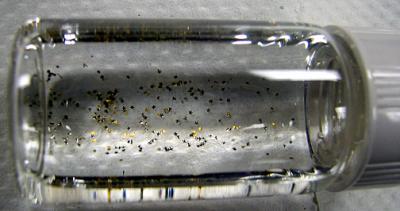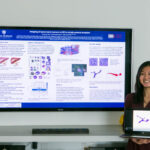Microscopic grippers used successfully in animal biopsies

Tiny, untethered microscale grippers have been successfully used to perform tissue biopsies in live animals, a study in the journal Gastroenterology reports. Researchers affiliated with the Johns Hopkins School of Medicine, Whiting School of Engineering and Institute for NanoBiotechnology developed the self-assembling microgrippers, called mu-grippers. The star-shaped devices use the animal’s own body heat to trigger them to clamp down around tissue to grab a sample like a tiny hand. Because the grippers are magnetic, they can later be retrieved for a minimally invasive procedure.
In the image above:
Dozens of dust-sized surgical mu- grippers in a vial. (Photo by Evin Gultepe, Gracias Lab, Johns Hopkins University)
David Gracias, the principal investigator for the study and associate professor of chemical and biomolecular engineering, was quoted in a Johns Hopkins press release about the work: “This is the first time that anyone has used a sub-millimeter-sized device — the size of a dust particle — to conduct a biopsy in a live animal … That’s a significant accomplishment. And because we can send the grippers in through natural orifices, it is an important advance in minimally invasive treatment and a step toward the ultimate goal of making surgical procedures noninvasive.”
Read more here.
Latest Posts
-
 Q&A with PSON Intern Jocelyn Hsu
August 19, 2021
Q&A with PSON Intern Jocelyn Hsu
August 19, 2021
-
 Start Up Founders from Johns Hopkins Aim to Stop Spread of Cancer
August 3, 2021
Start Up Founders from Johns Hopkins Aim to Stop Spread of Cancer
August 3, 2021
-
 Protein Appears to Prevent Tumor Cells from Spreading Via Blood Vessels
July 15, 2021
Protein Appears to Prevent Tumor Cells from Spreading Via Blood Vessels
July 15, 2021


